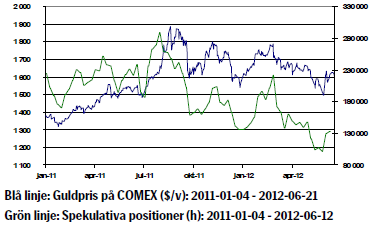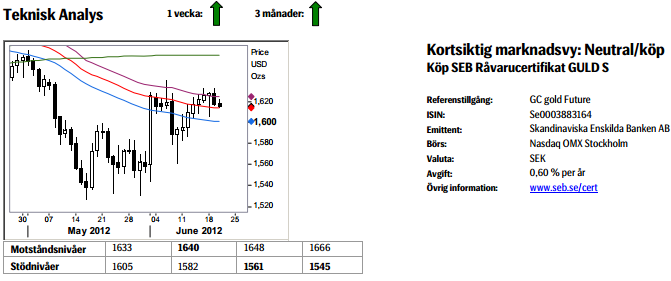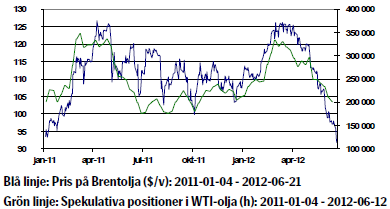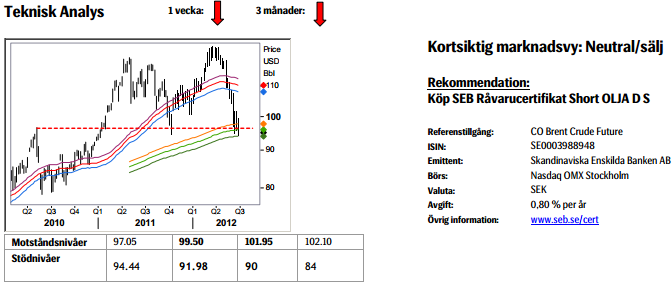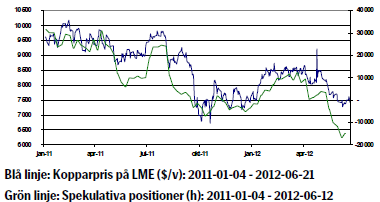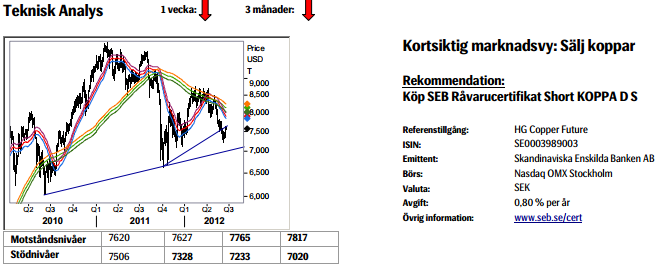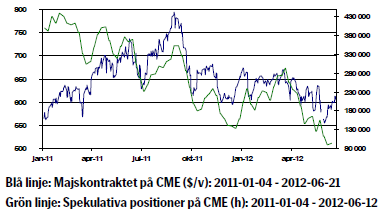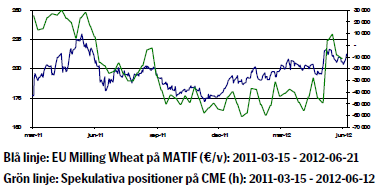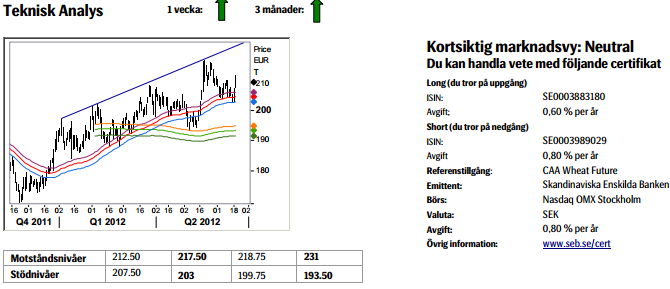Analys
SEB – Råvarukommentarer vecka 25 2012
Sammanfattning: Denna vecka
- Brett råvaruindex: -0,21 %
UBS Bloomberg CMCI TR Index - Energi: -2,95 %
UBS Bloomberg CMCI Energy TR Index - Ädelmetaller: -2,13%
UBS Bloomberg CMCI Precious Metals TR Index - Industrimetaller: -1,71 %
UBS Bloomberg CMCI Industrial Metals TR Index - Jordbruk: +4,46 %
UBS Bloomberg CMCI Agriculture TR Index
Kortsiktig marknadsvy:
Guld: Neutral/köp
Olja: Neutral/sälj
Koppar: Sälj
Majs: Sälj
Vete: Neutral
Guld
Guldpriset har fallit 1,6 procent i veckan och fortsätter att falla idag. Gårdagens Fed-möte gav inte det positiva genomslag man hade hoppats på. Förhoppningarna att Fed skulle intervenera kraftigt var höga men utgången blev försiktiga stimulanser där centralbanken säljer kortare stadspapper och köper längre löptider. Fed behöll även löftet att hålla räntan oförändrad tom slutet av 2014.
Utgången av det grekiska valet förra helgen lugnade marknaden men tendensen är att andningspauserna blir kortare och kortare. Blickarna riktades istället mot Spanien där behovet av en kapitalinjektion sannolikt är mer omfattande än vad tidigare indikerats.
I slutet på veckan kommer nya stresstester för den spanska banksektorn Den spanska 10-årsräntan steg över ohållbara 7.20 procent i veckan. Med sådana finansieringskostnader blir Spaniens situation allt mer ohållbar.
Det viktiga tyska ZEW- index som mäter förväntningarna hos analytiker och institutionella placerare kom in sämre än förväntat. På fredag publiceras ävendet tyska IFO-indexet som mäter humöret i det tyska näringslivet. En viss oro finns att tysk ekonomi visar tecken på försvagning vilket skulle försvåra krisarbetet i EMU-området betydligt. Man har sett i marknaden att hedgefonder positionerar sig för stigande tysk räntor, antingen för att riskerna för den tyska ekonomin ökar eller för att någon from av lösning kommer till stånd.
SEB:s analytiker håller än så länge fast vid synen att guld kommer att nå nya höjder innan året är slut men utfallsrummet är stort och en stop loss i $1500/ozt-trakten att rekommendera.
Teknisk analys: Paus i 55dagars bandet. Efter att nästan till fullo ha reverserat den tidigare sättningen har vi sedan några dagar parkerat i 55dagars bandet, hämtandes andan efter sju dagars uppgång. Efter innevarande konsolidering förväntas vi ta sats för att bryta upp över 1640,50 för att sedan utmana 233dagars bandet. Under ovanstående scenario kan vi inte falla tillbaka under 1,561 utan ett sådant brott skulle flytta oss till det neutrala lägret.
Olja
Brentoljan sjönk i veckan 6,3 procent. Efter gårdagens Fedmöte faller priset kraftigt.
Finansiella investerare positionerar sig avvaktande till ett högre oljepris på kort sikt.
De permanenta medlemmarna i FN:s permanenta säkerhetsråd har under veckans möte i Moskva igen diskuterat Irans kärnvapenprogram, dock utan tydliga framsteg. Mötet inleddes med att man konstaterade att det mest positiva man kunde förvänta sig av mötet var en överenskommelse om att ett nytt möte kommer att äga rum, vilket det kommer att göra i Istanbul den 3:e juli. Iran insisterar på ett lyftande av sanktioner och hävdade sin rätt att anrika uran, villkor som är osannolika att USA och EU kan acceptera. Oron kvarstår att geopolitiska spänningar kommer att intensifieras när nya sanktioner från USA och EU träder i kraft inom två veckor.
OPEC lyckades komma överens om att behålla produktionstaket på 30 mb/d vid sitt möte i Wien förra veckan men Saudiarabien kommer sannolikt inte att göra några snabba neddragningar av sin produktion. Irak har dessutom annonserat att man kommer att höja oljeproduktionen till 3,4 miljoner fat per dag från 3,2 miljoner fat per dag. Det finns för tillfället inga tecken på att den globala överproduktionen av olja kommer att ebba ut.
Onsdagen DOE siffror visade att råoljelager steg 2,9 miljoner fat till 387 miljoner fat, den högsta nivån sedan 1990. Vi ser att amerikanska driving season nu på allvar dragit upp efterfrågan på oljeprodukter.
Vi tror inte att Brentpriset kommer att falla kraftigt från nuvarande nivåer men den globala instabila makroekonomiska situation vi ser för tillfället tynger oljan.
Teknisk analys: På väg igenom falluckan! Hittills har stödet runt 96 förhindrat fortsatt nedgång men med varje studs lägre och lägre ökar hela tiden sannolikheten för att kraftigt brott lägre. Faktum är att om innevarande vecka slutar på nuvarande nivå eller lägre så är brottet ett faktum.
Koppar
Kopparpriset har fallit 1,4 procent under veckan. Effekter av turbulensen i Europa och en ytterligare lokal inbromsning i Kina på kort sikt kommer sannolikt att fortsätta skapa turbulens bland industrimetallerna.
I början av veckan lyfte statistik angående amerikansk husmarknad metallen till 7600 dollar per ton. Husbyggande står för 40 procent av amerikansk efterfrågan. Enligt World Bureau of Metal Statistics (WBMS) var USA världens andra största kopparkonsument 2011. Enligt International Copper Study Group kommer efterfrågan på koppar i USA att öka med 3,9 procent i år.
Kopparn faller kraftigt idag efter Federal Open Market Committees (FOMC) möte igår där tillväxtutsikterna sänktes. Uttalanden om en omfattande amerikansk QE3 (stimulanser) hade sannolikt lyft kopparn men gårdagens mera försiktiga utspel påverkar industrimetallsegmentet negativt idag.
Trots en europeisk skuldkris, vilken påverkar Kina negativt eftersom Europa står för en stor del av Kinas exportefterfrågan, har kinesiska slutkonsumenter funnit nuvarande prisnivåer intressanta för köp. Den för kopparn viktiga fastighetsmarknaden har i Kina blivit rejält avkyld och mycket talar för att man även i Kina kommer att stimulera ekonomin vilket kommer att ge stöd åt bostadssektorn och genom den ge stöd åt kopparpriset. Har man en längre tidshorisont kan det vara intressant att köpa koppar vid prisdippar men vi förväntar oss fortsatt svängig marknad.
Teknisk analys: Återtest av trendlinjen. Den mindre uppgång som noterats senare tid ska med största sannolikhet ses som ett återtest och bekräftelse av brottet av en kortar trendlinje. Vi är därför av åsikten att man ska sälja nuvarande nivåer för en fortsättning ned mot nacklinjen (av den möjliga huvud skuldra toppformationen). Först vid en uppgång över 7817 måste vi ta oss en ordentlig funderare över vår spelplan.
Majs
USDA crop report rapport visar att kvalitén på kommande majs skörd i USA har påverkats negativt av den senaste tidens mycket varma och torra väder, något som fick majspriset att stiga hela tio procent under veckan.
Jordbrukssektorn faller något efter gårdagens Fedmöte men sektorn är ändå den som bäst står emot det breda råvaruprisfallet.
Enligt USDA crop report är har andelen good/excellent minskat till 63 procent jämfört med 66 procent föregående vecka. Det är den lägsta siffran sedan 2008 och är långt under de senaste fem åren som legat på 69 procent.
Framöver kommer nederbörden att vara avgörande för skördens storlek och kvalitet. De nordligaste delarna av USA har haft en god mängd nederbörd medan de centrala och södra delarna har haft torka. Enligt väderprognoser förväntas det torra vädret att fortsätta och med det är det svårt att förvänta sig den rekordskörd som USDA tidigare prognostiserat.
Teknisk analys: Upp från ett slagigt intervall. Lite blåslagna efter en del oförutsedda svängningar har vi nu lämnat ovädersområdet bakom oss. En lite klarare bild pekar på sannolikt fortsatt uppgång och fokus för kommande veckan ligger därför på 1) huruvida vi lyckas passera 55dagars bandet eller ej samt 2) om vi passerar bandet den övre delen av den årslånga svagt sluttande kanalen, just nu vid ~654.
Vete
Spannmålen fortsätter att vara ovilliga att falla tillbaka i någon större utsträckning och vetepriset steg 4,3 procent under veckan. Fortsatt torra förhållanden på stora delar av norra halvklotet (primärt USA och Europe) håller uppe riskpremien. Förhållandena är ännu inte allvarliga men kan snabbt bli om inte regn anländer. Den långsiktiga väderriskpremien har fått stöd från ökande risk för att el Niño slår till igen under andra halvåret.
Torkan i Ryssland fortsätter att driva vetepriset. Det torra och varma vädret förväntas dessutom att fortsätta.
I USA är det torra vädret också ett problem för vårvetet som man precis planterat. Vete är den fjärde största grödan man odlar i USA.
I Europa, där Matif-vetet är referens är vädret emellertid bättre med nederbörd och lägre temperaturer. De för vete viktiga länderna Ukraina och Ryssland har alltför torrt väder vilket kan komma att påverka skörden negativt.
Teknisk analys: Återigen köpare i bandet. Återigen verkar idén om att köparna skulle ånyo återvända i 55dagars bandet ha fungerat enligt plan. Vår medelsiktiga vy pekar fortfarande på att vi inte bara ska passera 2012 års topp (218.75) utan även 2011 års (231).
[box]SEB Veckobrev Veckans råvarukommentar är producerat av SEB Merchant Banking och publiceras i samarbete och med tillstånd på Råvarumarknaden.se[/box]
Disclaimer
The information in this document has been compiled by SEB Merchant Banking, a division within Skandinaviska Enskilda Banken AB (publ) (“SEB”).
Opinions contained in this report represent the bank’s present opinion only and are subject to change without notice. All information contained in this report has been compiled in good faith from sources believed to be reliable. However, no representation or warranty, expressed or implied, is made with respect to the completeness or accuracy of its contents and the information is not to be relied upon as authoritative. Anyone considering taking actions based upon the content of this document is urged to base his or her investment decisions upon such investigations as he or she deems necessary. This document is being provided as information only, and no specific actions are being solicited as a result of it; to the extent permitted by law, no liability whatsoever is accepted for any direct or consequential loss arising from use of this document or its contents.
About SEB
SEB is a public company incorporated in Stockholm, Sweden, with limited liability. It is a participant at major Nordic and other European Regulated Markets and Multilateral Trading Facilities (as well as some non-European equivalent markets) for trading in financial instruments, such as markets operated by NASDAQ OMX, NYSE Euronext, London Stock Exchange, Deutsche Börse, Swiss Exchanges, Turquoise and Chi-X. SEB is authorized and regulated by Finansinspektionen in Sweden; it is authorized and subject to limited regulation by the Financial Services Authority for the conduct of designated investment business in the UK, and is subject to the provisions of relevant regulators in all other jurisdictions where SEB conducts operations. SEB Merchant Banking. All rights reserved.
Analys
Tightening fundamentals – bullish inventories from DOE

The latest weekly report from the US DOE showed a substantial drawdown across key petroleum categories, adding more upside potential to the fundamental picture.

Commercial crude inventories (excl. SPR) fell by 5.8 million barrels, bringing total inventories down to 415.1 million barrels. Now sitting 11% below the five-year seasonal norm and placed in the lowest 2015-2022 range (see picture below).
Product inventories also tightened further last week. Gasoline inventories declined by 2.1 million barrels, with reductions seen in both finished gasoline and blending components. Current gasoline levels are about 3% below the five-year average for this time of year.
Among products, the most notable move came in diesel, where inventories dropped by almost 4.1 million barrels, deepening the deficit to around 20% below seasonal norms – continuing to underscore the persistent supply tightness in diesel markets.
The only area of inventory growth was in propane/propylene, which posted a significant 5.1-million-barrel build and now stands 9% above the five-year average.
Total commercial petroleum inventories (crude plus refined products) declined by 4.2 million barrels on the week, reinforcing the overall tightening of US crude and products.


Analys
Bombs to ”ceasefire” in hours – Brent below $70

A classic case of “buy the rumor, sell the news” played out in oil markets, as Brent crude has dropped sharply – down nearly USD 10 per barrel since yesterday evening – following Iran’s retaliatory strike on a U.S. air base in Qatar. The immediate reaction was: “That was it?” The strike followed a carefully calibrated, non-escalatory playbook, avoiding direct threats to energy infrastructure or disruption of shipping through the Strait of Hormuz – thus calming worst-case fears.

After Monday morning’s sharp spike to USD 81.4 per barrel, triggered by the U.S. bombing of Iranian nuclear facilities, oil prices drifted sideways in anticipation of a potential Iranian response. That response came with advance warning and caused limited physical damage. Early this morning, both the U.S. President and Iranian state media announced a ceasefire, effectively placing a lid on the immediate conflict risk – at least for now.
As a result, Brent crude has now fallen by a total of USD 12 from Monday’s peak, currently trading around USD 69 per barrel.
Looking beyond geopolitics, the market will now shift its focus to the upcoming OPEC+ meeting in early July. Saudi Arabia’s decision to increase output earlier this year – despite falling prices – has drawn renewed attention considering recent developments. Some suggest this was a response to U.S. pressure to offset potential Iranian supply losses.
However, consensus is that the move was driven more by internal OPEC+ dynamics. After years of curbing production to support prices, Riyadh had grown frustrated with quota-busting by several members (notably Kazakhstan). With Saudi Arabia cutting up to 2 million barrels per day – roughly 2% of global supply – returns were diminishing, and the risk of losing market share was rising. The production increase is widely seen as an effort to reassert leadership and restore discipline within the group.
That said, the FT recently stated that, the Saudis remain wary of past missteps. In 2018, Riyadh ramped up output at Trump’s request ahead of Iran sanctions, only to see prices collapse when the U.S. granted broad waivers – triggering oversupply. Officials have reportedly made it clear they don’t intend to repeat that mistake.
The recent visit by President Trump to Saudi Arabia, which included agreements on AI, defense, and nuclear cooperation, suggests a broader strategic alignment. This has fueled speculation about a quiet “pump-for-politics” deal behind recent production moves.
Looking ahead, oil prices have now retraced the entire rally sparked by the June 13 Israel–Iran escalation. This retreat provides more political and policy space for both the U.S. and Saudi Arabia. Specifically, it makes it easier for Riyadh to scale back its three recent production hikes of 411,000 barrels each, potentially returning to more moderate increases of 137,000 barrels for August and September.
In short: with no major loss of Iranian supply to the market, OPEC+ – led by Saudi Arabia – no longer needs to compensate for a disruption that hasn’t materialized, especially not to please the U.S. at the cost of its own market strategy. As the Saudis themselves have signaled, they are unlikely to repeat previous mistakes.
Conclusion: With Brent now in the high USD 60s, buying oil looks fundamentally justified. The geopolitical premium has deflated, but tensions between Israel and Iran remain unresolved – and the risk of missteps and renewed escalation still lingers. In fact, even this morning, reports have emerged of renewed missile fire despite the declared “truce.” The path forward may be calmer – but it is far from stable.
Analys
A muted price reaction. Market looks relaxed, but it is still on edge waiting for what Iran will do

Brent crossed the 80-line this morning but quickly fell back assigning limited probability for Iran choosing to close the Strait of Hormuz. Brent traded in a range of USD 70.56 – 79.04/b last week as the market fluctuated between ”Iran wants a deal” and ”US is about to attack Iran”. At the end of the week though, Donald Trump managed to convince markets (and probably also Iran) that he would make a decision within two weeks. I.e. no imminent attack. Previously when when he has talked about ”making a decision within two weeks” he has often ended up doing nothing in the end. The oil market relaxed as a result and the week ended at USD 77.01/b which is just USD 6/b above the year to date average of USD 71/b.

Brent jumped to USD 81.4/b this morning, the highest since mid-January, but then quickly fell back to a current price of USD 78.2/b which is only up 1.5% versus the close on Friday. As such the market is pricing a fairly low probability that Iran will actually close the Strait of Hormuz. Probably because it will hurt Iranian oil exports as well as the global oil market.
It was however all smoke and mirrors. Deception. The US attacked Iran on Saturday. The attack involved 125 warplanes, submarines and surface warships and 14 bunker buster bombs were dropped on Iranian nuclear sites including Fordow, Natanz and Isfahan. In response the Iranian Parliament voted in support of closing the Strait of Hormuz where some 17 mb of crude and products is transported to the global market every day plus significant volumes of LNG. This is however merely an advise to the Supreme leader Ayatollah Ali Khamenei and the Supreme National Security Council which sits with the final and actual decision.
No supply of oil is lost yet. It is about the risk of Iran closing the Strait of Hormuz or not. So far not a single drop of oil supply has been lost to the global market. The price at the moment is all about the assessed risk of loss of supply. Will Iran choose to choke of the Strait of Hormuz or not? That is the big question. It would be painful for US consumers, for Donald Trump’s voter base, for the global economy but also for Iran and its population which relies on oil exports and income from selling oil out of that Strait as well. As such it is not a no-brainer choice for Iran to close the Strait for oil exports. And looking at the il price this morning it is clear that the oil market doesn’t assign a very high probability of it happening. It is however probably well within the capability of Iran to close the Strait off with rockets, mines, air-drones and possibly sea-drones. Just look at how Ukraine has been able to control and damage the Russian Black Sea fleet.
What to do about the highly enriched uranium which has gone missing? While the US and Israel can celebrate their destruction of Iranian nuclear facilities they are also scratching their heads over what to do with the lost Iranian nuclear material. Iran had 408 kg of highly enriched uranium (IAEA). Almost weapons grade. Enough for some 10 nuclear warheads. It seems to have been transported out of Fordow before the attack this weekend.
The market is still on edge. USD 80-something/b seems sensible while we wait. The oil market reaction to this weekend’s events is very muted so far. The market is still on edge awaiting what Iran will do. Because Iran will do something. But what and when? An oil price of 80-something seems like a sensible level until something do happen.
-

 Nyheter3 veckor sedan
Nyheter3 veckor sedanStor uppsida i Lappland Guldprospekterings aktie enligt analys
-

 Nyheter4 veckor sedan
Nyheter4 veckor sedanBrookfield ska bygga ett AI-datacenter på hela 750 MW i Strängnäs
-

 Nyheter3 veckor sedan
Nyheter3 veckor sedanSilverpriset släpar efter guldets utveckling, har mer uppsida
-

 Nyheter3 veckor sedan
Nyheter3 veckor sedanUppgången i oljepriset planade ut under helgen
-

 Nyheter3 veckor sedan
Nyheter3 veckor sedanLåga elpriser i sommar – men mellersta Sverige får en ökning
-

 Analys3 veckor sedan
Analys3 veckor sedanVery relaxed at USD 75/b. Risk barometer will likely fluctuate to higher levels with Brent into the 80ies or higher coming 2-3 weeks
-

 Nyheter2 veckor sedan
Nyheter2 veckor sedanMahvie Minerals växlar spår – satsar fullt ut på guld
-

 Nyheter1 vecka sedan
Nyheter1 vecka sedanOljan, guldet och marknadens oroande tystnad



